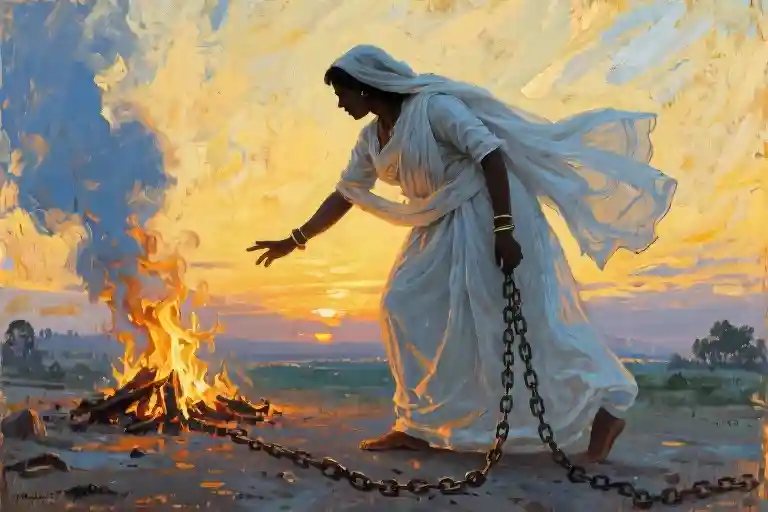The phone rang at 3:17 AM with that particular shrillness that only carries bad news. By the time I reached the hospital, the doctors had already pronounced the time of death – massive cardiac arrest, they called it. My father’s body lay on the stainless steel table, his face strangely peaceful for someone who had fought so hard in life. I reached out to touch his hand, still warm, when my uncle pulled me back. ‘Not now,’ he said. ‘The men need to prepare him.’
Morning came too quickly. The pallbearers arrived with a makeshift bamboo stretcher, their bare feet slapping against the marble floor of our family home. As they lifted my father’s shrouded body, I moved to join the procession – only to find my mother’s trembling hand gripping my wrist. ‘We don’t go,’ she whispered. Behind her, my aunts formed a silent wall of pastel-colored saris, their faces streaked with tears they wouldn’t let fall. Through the open doorway, I watched the men carry my father away, their white dhotis fluttering like surrender flags in the dawn light. The neighborhood stray dogs began howling as the procession turned the corner, their cries mingling with the priest’s Sanskrit chants until both faded into the humid air.
That’s when I understood the cruel arithmetic of grief in our culture: daughterhood divided by gender equals silence. The same hands that had buttoned my school uniform, braided my hair, packed my tiffin box – those hands weren’t permitted to light his funeral pyre. My mother, who had shared his bed for thirty-two years, wouldn’t see his body consumed by flames. We were given cotton wicks and sesame seeds to pray with at home, as if mourning required separate facilities.
In the years since, I’ve learned this tradition traces back to the Dharmashastra texts that declared women ‘ritually impure’ during menstruation and childbirth. But nowhere do those ancient scriptures explain why impurity should extend to a daughter’s farewell. The real unspoken rule was simpler: patriarchy couldn’t risk women witnessing what happens to a man’s earthly remains. If we saw how quickly fire reduces muscle to ash, we might stop believing in male invincibility.
Through the barred window of our upstairs sitting room, I watched the smoke rise from the crematorium chimney three kilometers away. My sister and I counted the minutes between each black plume – thirty-seven, then forty-two, then fifty-five – as if timing the intervals could tell us which part of our father was burning. The scent of sandalwood and ghee drifted through our neighborhood, clinging to laundry lines and children’s hair. By afternoon, even the crows stopped circling. That’s how I knew he was gone.
The Forbidden Goodbye: A Daughter’s Wound
The hospital room smelled of antiseptic and something else—something metallic and final. My father’s body lay still on the bed, his hands already cooling when I reached for them. A male cousin intercepted my movement, his grip firm on my wrist. ‘Not you,’ he said quietly. ‘The women don’t touch the body after death.’ His words hung between us, heavier than the white sheet they’d drawn over my father’s face.
That night, the men gathered in the living room to discuss the funeral arrangements. I sat with my mother and sister in the adjacent kitchen, straining to hear through the thin partition wall. My uncle’s voice carried clearly: ‘We’ll take him to the cremation grounds at dawn. The women will stay here.’ No one asked our opinion. No one even looked our way when the meeting ended. The decision had been made centuries before any of us were born.
When morning came, I watched through the barred window as they carried my father away on a bamboo stretcher. The street was still dark, but I could see the shapes of my brothers and uncles forming a procession. Someone had tied a white cloth around my youngest brother’s forehead—the mark of the chief mourner, a role none of us sisters were eligible for. My mother stood beside me, her fingers digging into my arm as the men turned the corner. Then we heard it—the first strike of the temple bell signaling the start of antim sanskar, the final rite we wouldn’t be allowed to witness.
The sound traveled farther than the procession. Long after the men had disappeared, the bell’s metallic echo reached our kitchen where we sat—three women who’d loved him in life but were deemed unworthy to accompany him in death. My sister began folding the laundry with violent precision. My mother stared at the stove where she’d once cooked my father’s favorite meals. And I? I pressed my forehead against the cool tile wall, imagining the flames that were consuming not just his body, but my chance to say goodbye properly.
Later, when the men returned with the ashes, they spoke in hushed tones about the ceremony—how the fire had crackled, how the priest had chanted, how my brother had performed the kapala kriya by breaking the skull with a bamboo stick. These details were given to us like gifts we hadn’t asked for, each one a fresh cut. No one mentioned the absence of his daughters. No one acknowledged that while they’d been reciting Sanskrit verses, we’d been counting the minutes with nothing but our silenced grief for company.
That evening, I found my father’s reading glasses on his bedside table. They were cold when I picked them up, the lenses smudged from his last use. I held them to my face, trying to see the world as he had. But all I saw was my own distorted reflection—a daughter denied the basic human right to mourn her father fully, simply because tradition had decreed her tears less sacred than a man’s.
The Anatomy of a Thousand-Year-Old Rule: Who Defines Women’s Right to Mourn?
The weight of tradition often feels heaviest when it lands on grieving shoulders. For years, I believed the prohibition against women attending Hindu last rites was some immutable divine law, etched in stone by gods themselves. It wasn’t until I stumbled upon an old copy of the Manusmriti in a Delhi library that the human origins of this oppression became painfully clear.
Section 5.156 stared back at me like an ancient indictment: “Women are considered ritually impure during menstruation and death ceremonies; their presence pollutes sacred spaces.” The brittle pages smelled of decay, yet their ideas still breathed in modern India. What shocked me wasn’t the text’s existence – but realizing how selectively these verses get enforced. The same scripture prohibits widows from remarrying (5.158), yet urban elites conveniently ignore that provision while upholding funeral bans.
A Brahmin priest in Varanasi (who requested anonymity) peeled back another layer during our interview: “It was never about purity. The funeral fire tradition began when property needed protection from daughters who might marry outside the caste.” His trembling hands sketched a family tree in spilled chai. “By keeping women away from cremation grounds, men maintained control over ancestral land transfers. The ‘impurity’ myth just made it palatable.”
This economic angle explains why the custom persists strongest in propertied communities. In Kerala’s fishing villages, where inheritance follows matrilineal traditions, I witnessed women in simple cotton saris walking freely into smoke-filled crematoriums. At Thiruvallam Temple near Thiruvananthapuram, a progressive priestess named Devika has conducted mixed-gender antim sanskar since 2012. “When we started,” she told me, “old men predicted crop failures. Now they bring granddaughters to light the pyre.”
The contradictions multiply when you track how these rules bend for power. Queens of the Mewar dynasty historically presided over royal funerals. Modern politicians’ wives suddenly become “exceptionally pure” during state funerals. Meanwhile, my college friend Priya – a cardiologist – wasn’t permitted to perform her own father’s last rites because “stethoscopes don’t override ovaries.”
What emerges isn’t some sacred tradition, but a patchwork of convenient justifications stitched together across centuries. The threads unravel when pulled: if women are too “impure” to witness cremation, why do they handle corpses during cholera outbreaks? If daughters can’t be trusted with funeral fires, why do mothers light diyas for generations?
Perhaps the most damning evidence comes from archaeology. Pre-Vedic burial sites like Harappa show no gender segregation in death rituals. The discrimination arrived later, codified precisely when Brahminical texts began systematizing caste and gender hierarchies. As historian Romila Thapar notes: “Funeral customs didn’t fall from heaven – they rose from very human struggles over power and resources.”
Now the tectonic plates of tradition are shifting again. Last monsoon season, I watched a young woman in Kochi argue her way into her uncle’s cremation ceremony. “He raised me,” she declared, clutching the sandalwood garland. The priest hesitated, then stepped aside. No lightning struck. The earth didn’t tremble. Just another ancient wall crumbling, one determined daughter at a time.
The Stories They Couldn’t Tell: When Indian Women Are Denied Goodbye
The New Delhi journalist wore oversized sunglasses and a baseball cap pulled low as she adjusted the drone controls in a nearby park. Her grandfather’s funeral pyre burned 200 meters away – close enough to smell the sandalwood, far enough to remain ‘in her place’ as a woman. The live feed on her phone showed uncles and cousins performing rituals she had studied for months, preparing to light the fire she was forbidden to touch. ‘I needed to see it with my own eyes,’ she told me later, her voice cracking. ‘Not through some male relative’s secondhand description.’
In rural Bihar, a 32-year-old widow sat cross-legged on the mud floor of her in-laws’ home while her husband’s body burned at the cremation grounds. ‘They said a widow’s presence would bring bad luck,’ she recounted, tracing circles in the ash that had fallen from the ceremonial lamp. The village priest had warned that if she so much as glimpsed the funeral procession, her husband’s soul might wander lost for eternity. Her daughters – ages 8 and 11 – weren’t permitted to go either, setting a pattern she feared would repeat through generations.
Perhaps most daring were the Hyderabad sisters who borrowed their brother’s kurta pajamas, rubbed charcoal on their faces to mimic stubble, and slipped into the all-male funeral gathering for their youngest sibling. ‘We kept our heads down and voices low,’ the elder sister explained. Their disguise held until the moment when, overcome with grief, one sister reached out to touch the bier – her slender wrists and hennaed fingers betraying her gender. The ensuing uproar cut their mourning short, but not before they’d broken an unspoken barrier. ‘For fifteen minutes,’ the younger sister said, ‘we existed as people who loved him, not as women who shouldn’t.’
These stories share a common thread – the creative, sometimes risky lengths Indian women go to participate in rituals they’re technically forbidden from. The drone operator, the confined widow, the disguised sisters – each found her own way to say goodbye despite systems designed to silence her grief. Their methods differ, but their motivation remains identical: the fundamental human need to witness a loved one’s passage, to feel closure isn’t something granted or withheld by gender.
What struck me most wasn’t their defiance, but what followed it. The journalist faced family ostracization for her ‘disrespect.’ The widow’s daughters now question why they must hide during village funerals. The sisters’ act inspired six other local women to openly attend a funeral the following month – small cracks in a centuries-old wall. These aren’t just stories about exclusion; they’re about the ripple effects that occur when someone refuses to accept that love and mourning have rules.
In Chennai, a 45-year-old daughter fought her way into the crematorium by citing a 2014 high court ruling about equal funeral rights. In Jaipur, a group of mothers now brings their children of both genders to funerals, normalizing what was once unthinkable. The patterns are shifting, not through sweeping reforms but through countless personal stands – each one proving that traditions can bend when human need presses hard enough against them.
Yet for every woman who finds a way, countless more remain behind that invisible line, their grief deemed less legitimate by virtue of their anatomy. The most painful part isn’t always the exclusion itself, but the message it sends: that their love, their loss, their very presence could somehow taint a sacred moment. As one grandmother in Kerala whispered to me, ‘They act like our tears are dirtier than our brothers’.’
These stories matter because they reveal what happens when you tell half a population their grief must be quieter, smaller, more convenient. They show the ingenious and heartbreaking ways women carve out space to mourn in systems that deny them the right. Most importantly, they remind us that funeral customs aren’t about the dead – they’re about who gets to be fully human in life’s most vulnerable moments.
When Pyres Have No Gender: A Global Perspective on Funeral Rights
The weight of my father’s absence still lingers years later, particularly when I encounter alternative ways cultures honor their dead. In Japan, the eldest daughter often leads Buddhist funeral rites, her hands steady as she guides incense smoke toward ancestral altars. Footage from Bali shows Hindu women in white sarongs carrying bamboo stretchers through sea mist, their voices chanting prayers alongside male relatives. These images unsettled me at first – not because they seemed strange, but because they revealed what my own tradition had stolen from me.
The First Daughter’s Right: Japanese Buddhist Traditions
At Tokyo’s Sensō-ji temple, I watched a woman in her sixties light the memorial lantern for her parents. As the eldest child, she directed younger siblings in ritual preparations – arranging lotus flowers, offering rice cakes, reciting sutras with the attending priest. “In our family,” she told me later over tea, “death duties follow birth order, not gender.” This practice stems from Buddhism’s philosophical rejection of caste and gender hierarchies, though local customs add nuance. Contemporary Japanese funerals increasingly blend traditions, with daughters frequently serving as chief mourners (tōya) regardless of marital status. The 2021 Japan Consumer Association survey found 68% of urban funerals had female primary organizers, a seismic shift from postwar norms.
Reformed Flames: Bali’s Progressive Hinduism
The cracking of coconut shells underfoot marked my walk with Ni Luh through her village’s cremation grounds. As a Hindu priestess in Ubud, she regularly performs ngaben (cremation) ceremonies. “When tourists ask why women carry bodies here,” she said, adjusting her ceremonial sash, “I tell them our ancestors never wrote that rule.” Balinese Hinduism preserves ancient elements lost in mainland Indian practice, including female ritual leadership. Social media videos of women bearing mock corpses during Ngaben Ngirit purification rites went viral in 2022, sparking debates in Indian Hindu forums. What outsiders view as exotic tradition actually represents continuous reform – Bali’s Hindu council officially endorsed mixed-gender funeral participation in 2015 after youth-led advocacy.
Diaspora Innovations: American Hindu Adaptations
At a California funeral home, I met Priya arranging her grandfather’s Antyesti. “Our temple committee voted last year,” she explained, pointing to women preparing the ghee-coated logs. “Now anyone who loved the deceased can join the final steps.” Second-generation Indian Americans are remixing traditions, creating space for daughters to light pyres and wives to recite Rigvedic verses. The Hindu American Foundation’s 2023 memorial guidelines explicitly state: “No participant should be excluded based on gender.” These adaptations reveal how immigrant communities negotiate between preserving culture and rejecting oppression – a delicate balance yielding new funeral lexicons where pronouns don’t dictate roles.
Witnessing these global variations forced me to confront an uncomfortable truth: the customs that barred me from my father’s cremation weren’t eternal laws, but choices. When the Japanese daughter prays, when Balinese women lift bamboo biers, when Indian-American girls scatter ashes into the Pacific – they prove that mourning needs no gender. The pyre only asks for love.
Breaking the Silence: An Action Guide for Change
The weight of tradition can feel immovable when you’re standing alone, but every revolution begins with someone refusing to accept “this is how it’s always been.” If you’ve ever been excluded from saying a proper goodbye to a loved one because of your gender, here are concrete ways to challenge these discriminatory funeral customs in India.
Legal Pathways: Your Constitutional Rights
Article 14 of the Indian Constitution guarantees equality before the law – a provision several women have successfully used to challenge exclusionary funeral practices. In 2018, a Delhi High Court ruling affirmed that adult daughters have equal rights to perform last rites. Connect with organizations like the Human Rights Law Network (HRLN) who provide pro bono legal support for such cases. Their gender justice unit maintains a list of sympathetic lawyers across states who specialize in fighting discriminatory customs while respecting religious sentiments.
Digital Activism: #DaughtersAlsoLightThePyre
Social media has become an unexpected ally in this fight. The viral campaign #DaughtersAlsoLightThePyre collected over 15,000 stories from women denied funeral participation rights. Sharing your experience with this tag does three things: creates visibility, builds solidarity, and pressures religious institutions to reform. When posting, include specific details – which temple/town enforced the ban, what explanations were given, how it affected your grieving process. This evidentiary approach makes the abstract discrimination painfully concrete.
Three Immediate Steps You Can Take
- Document Family Narratives: Record older relatives explaining why these rules exist. You’ll often find the answers reveal economic control (preventing women from claiming inheritance through ritual participation) rather than spiritual logic. These recordings become powerful tools for consciousness-raising.
- Attend Gender Sensitivity Workshops: Organizations like Breakthrough India train communities to separate cultural practices from patriarchal control. Their “Rituals Reimagined” program specifically addresses funeral rights, teaching negotiation tactics for dealing with resistant family members.
- Strategic Story Sharing: Forward articles like this to exactly three people: the most traditional elder in your family, the most progressive young male relative, and someone outside your community. This triangulation approach bypasses defensive reactions by presenting the issue through multiple perspectives.
Remember what the Kerala women’s collective demonstrated – when just 5% of a community starts persistently challenging a practice, it becomes unsustainable to maintain. Your individual act of resistance, whether quietly attending a forbidden ritual or openly questioning the elders, contributes to that critical mass. The funeral pyres that once excluded daughters will eventually light the way for change.
When Daughters Light the Pyre: A Decade of Defiance
The scent of marigolds and sandalwood paste always takes me back to that stifling June morning ten years ago. This year, on my father’s death anniversary, I crushed fresh petals between my fingers before scattering them into the Ganges—a ritual I’d been forbidden from performing as a twenty-three-year-old mourning daughter. The riverbank was crowded with families conducting shraddha ceremonies, but mine stood apart. My mother held the brass pot of sacred water while my sister and I, dressed in white cotton saris with our hair unbound, chanted the Sanskrit verses reserved for sons.
A group of elderly women paused their own rituals to stare. One clutched her grandson’s shoulder as if our rebellion might be contagious. Ten years earlier, their disapproval would have paralyzed me. Now, their whispers barely registered over the sound of my niece—just six years old—reciting the final prayer. Her high voice, untroubled by centuries of prohibition, carried further than the muttered objections.
The Walls We Didn’t Build
That first forbidden funeral shaped me more than any rite of passage ever could. The anger crystallized into something sharper over time—not the dull ache of powerlessness, but the clean edge of a tool meant for dismantling. When my cousin passed away three years later, I arrived at the cremation ground before dawn with three law students from Lady Shri Ram College. We stood shoulder-to-shoulder facing the shocked priest, copies of the Hindu Succession Act amendments tucked under our arms like spiritual armor.
‘You’ll bring misfortune,’ the old man warned, eyeing our uncovered heads.
‘Show me the scripture that says so,’ I countered. When he couldn’t—when all he offered were the same tired phrases about purity and tradition—something fundamental shifted in our family dynamics. My uncle later admitted he’d never actually questioned the custom until that moment.
Sparks Across the Country
This quiet revolution isn’t just happening in Delhi’s electric air. Last monsoon season, I received a grainy video from a village near Varanasi. In it, a daughter in a soaked blue sari shielded the funeral pyre from rain with her own body while male relatives hesitated. The caption read: ‘She wouldn’t let her father go cold.’ The clip spread through WhatsApp groups with #WomenLightToo, sparking debates in tea shops from Chennai to Jaipur.
Even conservative strongholds are cracking. When Kerala’s Devaswom Board ruled last year that women could enter Sabarimala’s sanctum, it opened floodgates we’d barely dared imagine. Now young girls in half a dozen states are asking why temple doors and funeral rights should be any different.
The Fire We Carry Forward
Some changes are harder to measure. There’s no law yet guaranteeing Hindu women’s right to conduct last rites, no nationwide policy dismantling the practice. But in my niece’s classroom last month, when the teacher described funeral customs, no one batted an eye at her drawing of a girl holding the ceremonial flame. That unthinking acceptance—the quiet assumption of equality in a child’s crayon strokes—feels more transformative than any legislation.
So I’ll keep bringing my sister’s daughters to the riverbank each June. We’ll keep reciting the forbidden verses louder each year, until our voices wear grooves in the old stones of tradition. And when another grieving daughter somewhere in India searches online for ‘can women attend Hindu funerals,’ she’ll find this truth waiting: the walls are already crumbling. All that’s left is to step through.
In your culture, how do women say goodbye? Share your story below—every memory lights another spark.





